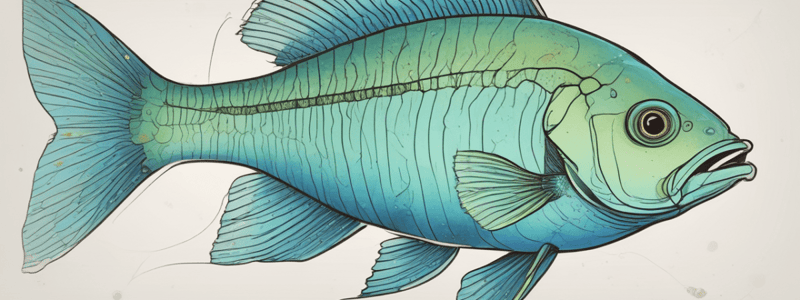Podcast
Questions and Answers
What is the significance of the concentration of sensitivity to water motion in the head region of some fish?
What is the significance of the concentration of sensitivity to water motion in the head region of some fish?
It is important for sensing vortex trails in the wakes of adjacent fishes in a school.
What is the advantage of having reduced lateral line elements along the flanks of some fish?
What is the advantage of having reduced lateral line elements along the flanks of some fish?
It reduces noise from turbulence beside the fish.
How do electric fishes generate electrical discharges?
How do electric fishes generate electrical discharges?
Through modified muscle tissue called electrocytes that are specialized for generating an ion current flow.
What is the resting state of the membranes of muscle cells and nerve cells in electric fishes?
What is the resting state of the membranes of muscle cells and nerve cells in electric fishes?
What is the function of electrical signals in weakly electric knife fishes and elephant fishes?
What is the function of electrical signals in weakly electric knife fishes and elephant fishes?
What is the purpose of electrical discharges in torpedo rays, electric catfish, and electric eels?
What is the purpose of electrical discharges in torpedo rays, electric catfish, and electric eels?
What is the primary reason for the imbalance of ion concentrations across the electrocyte membrane?
What is the primary reason for the imbalance of ion concentrations across the electrocyte membrane?
What is the potential difference across the cell when the smooth surface is depolarized?
What is the potential difference across the cell when the smooth surface is depolarized?
How do the electrocytes in the electric eel generate high voltages?
How do the electrocytes in the electric eel generate high voltages?
What is the maximum voltage that the South American electric eel can generate?
What is the maximum voltage that the South American electric eel can generate?
Which marine fishes are capable of generating specialized electrical discharges?
Which marine fishes are capable of generating specialized electrical discharges?
What is the function of the spinal motor neurons in the electric eel?
What is the function of the spinal motor neurons in the electric eel?
What is the primary mechanism by which weakly electric fishes detect the presence of nearby objects?
What is the primary mechanism by which weakly electric fishes detect the presence of nearby objects?
How do nonconductive objects, such as rocks, affect the electric field surrounding a weakly electric fish?
How do nonconductive objects, such as rocks, affect the electric field surrounding a weakly electric fish?
What is the likely origin of electroreception in vertebrates, based on the presence of electroreceptor cells in early fishlike vertebrates?
What is the likely origin of electroreception in vertebrates, based on the presence of electroreceptor cells in early fishlike vertebrates?
What is the significance of the kinocilium in electroreceptor cells?
What is the significance of the kinocilium in electroreceptor cells?
What is the region of the brain where impulses from electroreceptor cells are processed?
What is the region of the brain where impulses from electroreceptor cells are processed?
What is the significance of the frequency change in electric fish when they swim close to each other?
What is the significance of the frequency change in electric fish when they swim close to each other?
What unique feature of seawater allows sharks to detect the electrical activity of their prey?
What unique feature of seawater allows sharks to detect the electrical activity of their prey?
What is the role of the gel in the canal connecting the receptor to the surface pore in the ampullae of Lorenzini?
What is the role of the gel in the canal connecting the receptor to the surface pore in the ampullae of Lorenzini?
How do the electroreceptors of sharks respond to changes in the electric field surrounding an animal?
How do the electroreceptors of sharks respond to changes in the electric field surrounding an animal?
What type of nerve cells produce extremely brief changes in electrical potential, contributing to the detection of prey by sharks?
What type of nerve cells produce extremely brief changes in electrical potential, contributing to the detection of prey by sharks?
What is the significance of the threshold of detection of less than 0.01 microvolt per centimeter for the ampullary organs of sharks?
What is the significance of the threshold of detection of less than 0.01 microvolt per centimeter for the ampullary organs of sharks?
What type of activity generates electrical potential changes that sharks can detect using their electroreceptors?
What type of activity generates electrical potential changes that sharks can detect using their electroreceptors?
What is the effect of deflection of the kinocilium in one direction on the hair-cell transmembrane potential?
What is the effect of deflection of the kinocilium in one direction on the hair-cell transmembrane potential?
What is the purpose of the cupula in the lateral line system?
What is the purpose of the cupula in the lateral line system?
What is the function of the neuromast organ in the lateral line system?
What is the function of the neuromast organ in the lateral line system?
How do the hair cells in a pair signal the direction of cupula displacement?
How do the hair cells in a pair signal the direction of cupula displacement?
What is the effect of deflection of the kinocilium in the opposite direction on the hair-cell transmembrane potential?
What is the effect of deflection of the kinocilium in the opposite direction on the hair-cell transmembrane potential?
What is the significance of the lateral line system in fish?
What is the significance of the lateral line system in fish?
Flashcards are hidden until you start studying
Study Notes
Sensing and Electric Discharge in Fish
- Some fish have a large number of neuromasts on their heads, which might be important for sensing vortex trails in the wakes of adjacent fish in a school.
- Fish that form extremely dense schools, such as herrings, atherinids, and mullets, often lack lateral line organs along their flanks and retain canal organs only on their heads.
- These cephalic canal organs concentrate sensitivity to water motion in the head region, allowing the fish to sense the turbulence it is swimming into.
- The reduction of flank lateral line elements reduces noise from turbulence beside the fish.
Electric Fish
- Electric fish, such as the torpedo ray, electric catfish, and electric eel, can discharge enough electricity to stun prey animals and deter predators.
- Weakly electric fish, such as the knife fish and elephant fish, use electrical signals for courtship and territorial defense.
- These fish use modified muscle tissue to produce the electrical discharge, which is generated by specialized cells called electrocytes.
- Electrocytes are muscle cells that have lost the capacity to contract and are specialized for generating an ion current flow.
- When at rest, the membranes of muscle cells and nerve cells are electrically charged, with an imbalance of 84 millivolts due to sodium ion exclusion.
- When stimulated, sodium ions flow rapidly across the smooth surface, sending its potential to a positive 67 millivolts, resulting in a potential difference of 151 millivolts across the cell.
Electric Discharge in Fish
- Electric fish have stacks of electrocytes, which combine to produce high voltages.
- The South American electric eel has up to 10,000 layers of cells and can generate potentials in excess of 600 volts.
- Most electric fish are found in tropical freshwaters of Africa and South America, with few marine forms capable of generating specialized electrical discharges.
Electroreception in Other Vertebrates
- Electroreception is not restricted to a single group of aquatic vertebrates, and monotremes, such as the platypus and echidna, use electroreception to detect prey.
- Electroreception was likely an early feature of vertebrate evolution, with the brain of the lamprey responding to electric fields.
- All fish-like vertebrates of lineages that evolved before the neopterygians have electroreceptor cells, which fire when the environment around the kinocilium is negative relative to the cell.
Electroreception in Sharks and Rays
- Sharks have electroreceptors called the ampullae of Lorenzini on their heads, which detect the electrical activity that accompanies muscle contractions of their prey.
- The ampullae are sensitive to minute changes in the electric field surrounding an animal, with thresholds lower than 0.01 microvolt per centimeter.
- Sharks use their electrical sensitivity to detect prey, as all muscle activity generates electrical potential.
- The ampullae act like voltmeters, measuring differences in electrical potentials across the body surface.
Studying That Suits You
Use AI to generate personalized quizzes and flashcards to suit your learning preferences.




